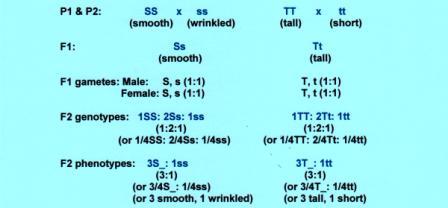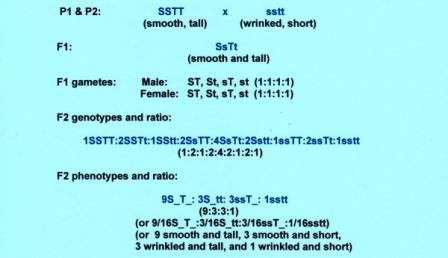The Mendelian Law of Independent Assortment states that each gene pair acts independently of the other.
Gregor Mendel demonstrated that the transmission of traits involving one gene pair (monohybrid inheritance) following the Law of Segregation remains constant even in dihybrid crosses in which parents differ in two sets of characters.
Stated another way, the segregation of alleles in one gene pair proceeds independently of the segregation of alleles in other gene pairs during sexual reproduction.
Known also as Mendel’s Second Law, it provides the fundamental rule in genetics that the intraallelic interaction characteristic of the Law of Segregation is maintained regardless of the number of gene pairs constituting the genotype.
However, there are exceptions to this rule.
Intraallelic interaction is the interaction of alleles (e.g. between S and s or between T and t) belonging to the same gene pair (e.g. Ss or Tt) as distinguished from interallelic interaction which is the interaction of alleles belonging to different gene pairs within the same genotype such as S and s in the pair Ss with T and t in the pair Tt.
The Law of Segregation in Monohybrid Inheritance
To understand the Law of Independent Assortment, it is necessary to go back to the Law of Segregation.
The pattern of transmission of traits in accordance with the Law of Segregation and the expected F2 genotypic and phenotypic ratios in the monohybrid crosses smooth x wrinkled seeds (SS x ss) and tall x short (TT x tt) are thus shown below:

In both crosses, the expected genotypic ratio in the second filial generation (F2) is 1 pure dominant: 2 hybrid dominant: 1 pure recessive, that is, 1SS:2Ss:1ss in the smooth x wrinkled cross and 1TT:2Tt:1tt in the tall x short cross.
As to the F2 phenotypes, the expected ratio in either cross is 3 dominant: 1 recessive.
The Law of Independent Assortment
The Law of Segregation is not restricted to monohybrid inheritance, it also applies to dihybrid crosses or any cross regardless of the number of gene pairs.
That is the Law of Independent Assortment.
The illustration below shows that the transmission of traits in each gene pair remains consistent with the law of segregation.
Both the alleles S for smooth and s for wrinkled seeds and the alleles T and t for tall and short, respectively, combine in the dihybrid (SsTt).
They subsequently segregate during sexual reproduction and, upon self-fertilization, are retransmitted to the selfed progeny in accordance with the probability constants derived from Mendel’s First Law.

In other words, the tendency of a garden pea plant to have either smooth or wrinkled seed is not affected by its tendency to become either tall or short and vice versa.
Stated by way of example, the 1/4 chance of a homozygous allelic pair (e.g. SS or ss) and the 3/4 chance of exhibiting the smooth character in the F2 are asserted regardless of the alleles present in the other gene pair as if the other gene pair is not existent.
This is an independent assortment.
Using the probability constants derived from Mendel’s Law of Segregation, that is, 1/4SS:2/4Ss:1/4ss or 1/4TT:2/4Tt:1/4tt for the F2 genotypes and 3/4S_ (orT_):1/4ss (or tt) for the F2 phenotypes; and applying the rule that the probability of a combination of alternative events is equal to the product (by multiplication) of the probabilities of the events, the genotypic and phenotypic ratios in the F2 of the dihybrid cross (SSTT x sstt) can be derived mathematically.
For the F2 genotypes, the ratio is 1SSTT: 2SSTt: 1SStt: 2SsTT: 4SsTt: 2Sstt: 1ssTT: 2ssTt: 1sstt or 1/16SSTT: 2/16SSTt: 1/16SStt: 2/16SsTT: 4/16SsTt: 2/16Sstt: 1/16ssTT: 2/16ssTt: 1/16sstt = 16/16.
The specific genotypes and phenotypes in the F2 and the mathematical procedure in the calculation of their respective probability values are given below.
For the F2 genotypes:
1/4SS x 1/4TT = 1/16 SSTT
1/4SS x 2/4Tt = 2/16 SSTt
1/4SS x 1/4tt = 1/16 SStt
2/4Ss x 1/4TT = 2/16 SsTT
2/4Ss x 2/4Tt = 4/16 SsTt
2/4Ss x 1/4tt = 2/16 Sstt
1/4ss x 1/4TT = 1/16 ssTT
1/4ss x 2/4Tt = 2/16 ssTt
1/4ss x 1/4tt = 1/16 sstt
For the F2 phenotypes
3/4S_ x 3/4T_ = 9/16 S_T_ (smooth seeded and tall)
3/4S_ x 1/4tt = 3/16 S_tt (smooth seeded and short)
1/4ss x 3/4T_ = 3/16 ssT_ (wrinkled seed and tall)
1/4ss x 1/4 tt = 1/16 sstt (wrinkled seed and short)
Therefore, the tendency of producing genotypes in the F2 that includes the allelic pair SS is 1/16 SSTT + 2/16 SSTt + 1/16 SStt = 4/16 or 1/4; with the pair Ss is 2/16 SsTT + 4/16 SsTt + 2/16 Sstt = 8/16 or 2/4; with the pair ss is 1/16 ssTT + 2/16 ssTt + 1/16 sstt = 4/16 or 1/4.
These values correspond to the ratio 1/4SS: 2/4Ss: 1/4ss.
This is exactly identical to the F2 genotypic ratio following Mendel’s Law of Segregation and further underscores the independent assortment of the S and s alleles despite the presence of the tall and/or short genes in the genotype.
The TT:Tt:tt F2 genotypic ratio would be the same, that is, 1:2:1.
Likewise, the independent assortment of alleles applies to the phenotypes.
The tendency of the F2 to exhibit the smooth and wrinkled seed characters or tall and short remains 3:1.
For smooth (S_), 9/16 S_T_ + 3/16 S_tt = 12/16 or 3/4 and for wrinkled seeds (ss), 3/16 ssT_ + 1/16 sstt = 4/16 or 1/4.
These are equivalent to the same ratio of 3:1 smooth and wrinkled obtained from the selfed monohybrid Ss as illustrated under the law of segregation.
